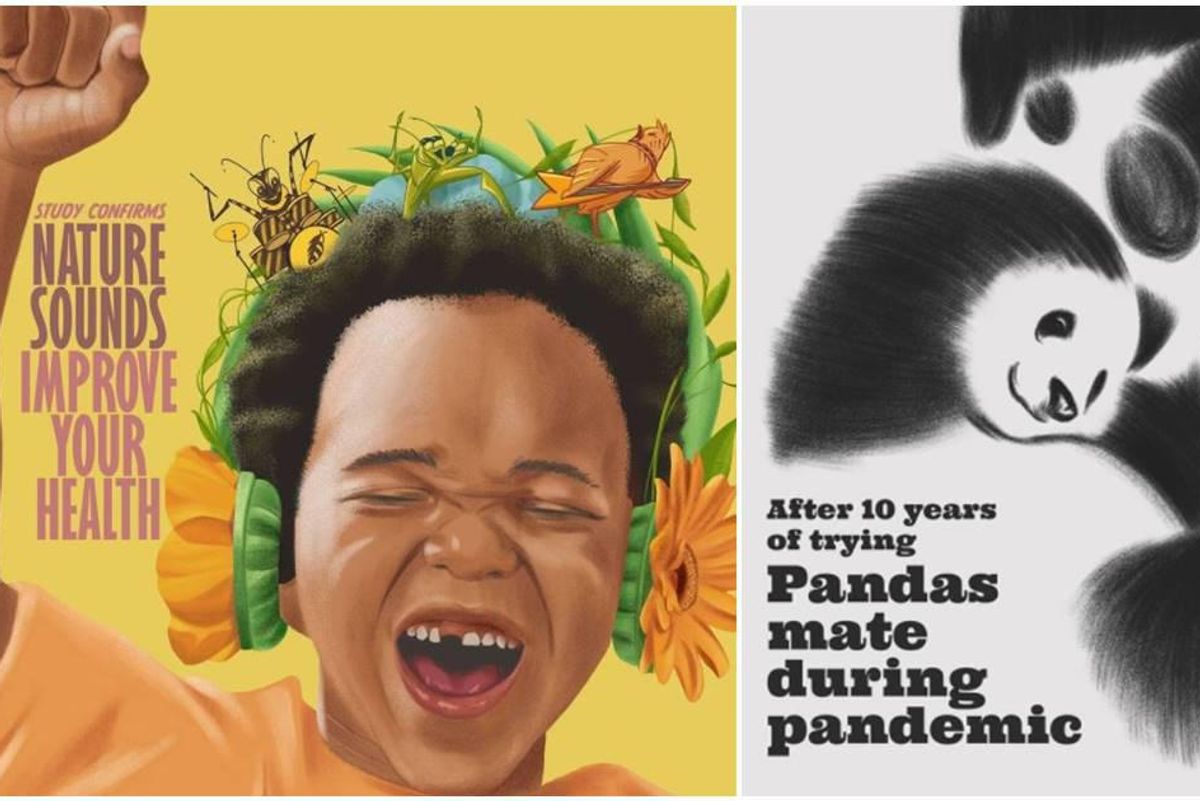Artist takes the best 'good news' stories and transforms them into masterful illustrations

Headlines from Unnewscessary.
At Upworthy, we know a thing or two about the challenges that come with trying to spread good news in a world that tends to thrive on negativity. There are two main reasons why bad news makes the headlines, whereas the good stuff tends to be hidden on the back page.
First, people have evolved to pay attention to things that could be a potential threat. Hence, why crime, war,and political outrage are usually the top stories of the day. Second, good news sometimes doesn’t happen overnight.
“Obviously sudden, noteworthy, and rare events are the ones that make headlines, whereas long-term slow, steady, incremental progress is just not as interesting,” Chelsea Follett, Editor of Human Progress, another positivity site, told Upworthy.
An illustrator has created a wonderful Instagram page where he illustrates good news headlines so “so you won't forget them,” he told Upworthy.
Unnewscessary presents fun, dramatic visualizations of the day’s positive news headlines to show people what they may have missed and to make the stories “easy to remember.”
@Unnewscessary started the project in 2019, just before the pandemic hit. His original goal was doing 100 illustrations of news items that “cannot be photographed,” but the work soon became an addiction.
He's proud to have posted dozens of positive news stories over the past two years, even though we’ve been living through a pandemic. “When you look over the whole gallery, given that most of them are good news, you can see what went well in the last two awful years,” he told Upworthy.
Waxworms eat plastic and poop alcohol.
The Instagram page has received a lot of positive responses, but @Unnewscessary's favorite was when a scientist contacted him out of the blue. “I got an email from a scientist that told me he's the one that made the discovery about waxworms that I illustrated. He was in awe!” he said.
@Unnewscessary believes that a lot of people are missing out on positive stories because they lack eye-catching share images.
"Some very interesting stories get lost in our feed because they have an ordinary cover picture, like a stock image that doesn’t say much,” he said. “That’s because some subjects are too abstract to be photographed, so editors are pairing them with something neutral and insipid.”
Here are 17 of the most memorable good news illustrations at Unnewscessary. Take a good look, you may have missed these headlines when they first came out.
Doctors in Canada can now prescribe national park trips to patients.
Study finds men wearing face masks are the most attractive.
Pets' welfare will be considered when couples divorce.
Interrupting sleep after a few minutes can boost creativity.
Airbnb opens up housing for 20,000 Afghan refugees.
Nature sounds improve your health.
The excavator driver from the Suez Canal said the memes made him work harder.
The four-day work week is becoming a thing.
QAnon members are going back to reality.
Monkeys at Bali temple can spot expensive items to steal and ransom for food.
Abortion is now legal in Argentina.
San Francisco plans a basic income pilot program for artists.
Pope Francis voices support for same-sex marriage.
Romania establishes the animal police.
The World Food Programme won the Nobel Prize.
The Tasmanian devil returns to Australia.
Brazil's Football Federation announces equal pay for women and men.
- John Krasinski just launched a 'Some Good News' TV show from his ... ›
- Artist illustrates good news stories from 2021 to highlight the ... ›
- 10 things that made us happy this week - Upworthy ›
- 10 things that will restore your faith in humanity - Upworthy ›
- 10 uplifting finds from around the internet this week - Upworthy ›
- People share good things happening in America - Upworthy ›
- Man returns woman's missing purse - Upworthy ›
- Lainey Molnar's comics illustrate feminism, women's issues - Upworthy ›

